
INVENTOR'S GUIDE INTERVIEW OF PHILIP EMEAGWALI
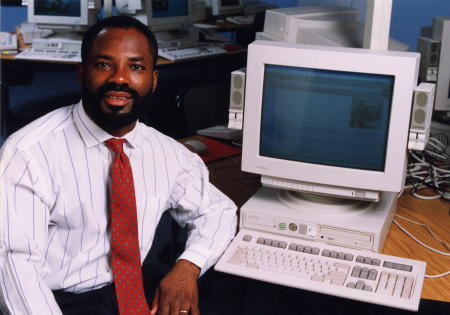
Philip Emeagwali
interviewed by Mary Bellis
for The Inventor's Guide.
 About Nigeria how do you envision your beginning affecting your end?
About Nigeria how do you envision your beginning affecting your end?
 Nigeria is a west African nation of over 100 million energetic
people. It is endowned with lots of natural resources but lacks human resources.
It was recently ranked by the World Bank
as the 13th poorest nation in the world. Due to financial reasons, I
dropped out of school after eight years of formal schooling. During
1967-70 period, my family was homeless. Sometimes, we slept in refugee
camps, abandoned school buildings and bombed houses.
Nigeria is a west African nation of over 100 million energetic
people. It is endowned with lots of natural resources but lacks human resources.
It was recently ranked by the World Bank
as the 13th poorest nation in the world. Due to financial reasons, I
dropped out of school after eight years of formal schooling. During
1967-70 period, my family was homeless. Sometimes, we slept in refugee
camps, abandoned school buildings and bombed houses.
The hardship of living in a refugee camp made me pyschologically
strong. It is called learning from the school of hard knocks. It made me street
smart. It equipped me with a greater sense of
determination and vision.
Adversities such as being homeless and going to prison has made many
people stronger. Nelson Mandela and Malcolm X came out of
prison stronger. The hardships that I encountered in the past
will help me succeed in the future.

Family photo taken with my cousin
Charles (third from right) with me standing on the right (December
1962 at Uromi, Nigeria). I dropped out of school four and half years later.
 You speak about the
influence nature's own creativity has had upon your science
theories, how did this begin?
You speak about the
influence nature's own creativity has had upon your science
theories, how did this begin?
 I have expertise
in five different fields which helps me to easily understand the analogy
between my scientific problems and those occuring in nature.
First, I identify an analogous problem in nature and borrow from it.
It is smarter to borrow from nature than to reinvent the wheels.
I have expertise
in five different fields which helps me to easily understand the analogy
between my scientific problems and those occuring in nature.
First, I identify an analogous problem in nature and borrow from it.
It is smarter to borrow from nature than to reinvent the wheels.
 Your education
during your teenage years was outside of the school system can
you talk about that experience?
Your education
during your teenage years was outside of the school system can
you talk about that experience?
 It was the toughest experience of my
life.
I dropped out of high school four times between the ages of 12 to 17.
When I enrolled in college at
age 19, I had a total of eight years of formal classroom education. As a result,
I was not comfortable with formal lectures and receiving regular homework assignments.
I preferred to study those subjects that were of interest to me.
It was the toughest experience of my
life.
I dropped out of high school four times between the ages of 12 to 17.
When I enrolled in college at
age 19, I had a total of eight years of formal classroom education. As a result,
I was not comfortable with formal lectures and receiving regular homework assignments.
I preferred to study those subjects that were of interest to me.
I learned by reading the classic but out-of-date works of Galileo,
Isaac Newton, Betrand Russell and Albert Einstein. Since there were
no formally trained scientists in my hometown, the famous commercial
city of Onitsha, I gained a word-of-mouth
reputation as an expert in mathematics, physics and astronomy and students came
to consult me in these subjects.
 What brought
about you leaving Africa?
What brought
about you leaving Africa?
 I wanted
to become a mathematician, physicist or astronomer. I could not study
these subjects at the cutting-edge level in Africa. During the week that I
arrived in the United States, I saw an airport, used a
a telephone, used a library, talked with a scientist, and was shown a
computer for the first time in my life.
I wanted
to become a mathematician, physicist or astronomer. I could not study
these subjects at the cutting-edge level in Africa. During the week that I
arrived in the United States, I saw an airport, used a
a telephone, used a library, talked with a scientist, and was shown a
computer for the first time in my life.
Today, I have access to a $55 million supercomputer while many African scientists
do not have access to a personal computer. The greater opportunity enabled me
to make important discoveries and inventions.
 In 1989 you won the coveted Gordon Bell Prize for your work with massively parallel computers.
You programmed the Connection Machine to compute a world record 3.1 billion calculations per
second using 65,536 processors to simulate oil reservoirs. This was done over the Internet. I was
wondering how you choose or found the 65,536 computers to help you?
In 1989 you won the coveted Gordon Bell Prize for your work with massively parallel computers.
You programmed the Connection Machine to compute a world record 3.1 billion calculations per
second using 65,536 processors to simulate oil reservoirs. This was done over the Internet. I was
wondering how you choose or found the 65,536 computers to help you?
 The 65,536
processors were inside the
Connection Machine. I accessed the Connection Machine over
the Internet. The Connection Machines owned by the United States
government laboratories
were made available to me because they were considered
impossible to program and there was no great demand for them
at that time. In fact, the
national laboratories that purchased them were embarrased because their
scientists could not program them and they were hardly
being used. The labs were happy that I was brave enough to attempt to
program it and the $5 million computer was left entirely to my use.
I was their human guinea pig.
The 65,536
processors were inside the
Connection Machine. I accessed the Connection Machine over
the Internet. The Connection Machines owned by the United States
government laboratories
were made available to me because they were considered
impossible to program and there was no great demand for them
at that time. In fact, the
national laboratories that purchased them were embarrased because their
scientists could not program them and they were hardly
being used. The labs were happy that I was brave enough to attempt to
program it and the $5 million computer was left entirely to my use.
I was their human guinea pig.
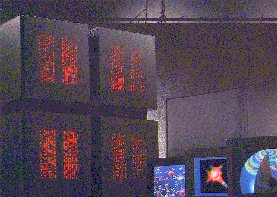
Click
here for full-scale 65536-processor Connection Machine.
 Can you describe the Connection Machine
and give us an explanation of how it all worked?
Can you describe the Connection Machine
and give us an explanation of how it all worked?
 The Connection Machine
was the most powerful computer in the world.
It is a complex computer and it will take forever to completely describe how
it works.
The Connection Machine
was the most powerful computer in the world.
It is a complex computer and it will take forever to completely describe how
it works.
Briefly, to program it requires an absolute understanding of how all 65,536
processors are interconnected. The processing nodes are configured
as a cube in a 12-dimensional universe, although we only
use it to solve
problems arising from our three-dimensional universe.
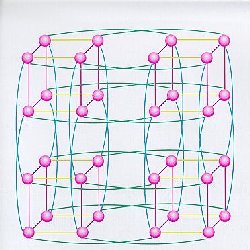
A 32-node cube in five-dimensional
universe.
To perform the world's fastest computation, I divided and
and evenly distributed the calculations among the
65,536 processors and then squeezed the most performance from the each
processor. It took me 1057 pages to describe the
hundreds of mathematical equations, algorithms and programming techniques
that I invented and used. The gory
details
will be of interest to only mathematicians and supercomputer nerds.
However, for your amusement, they include
equations such as


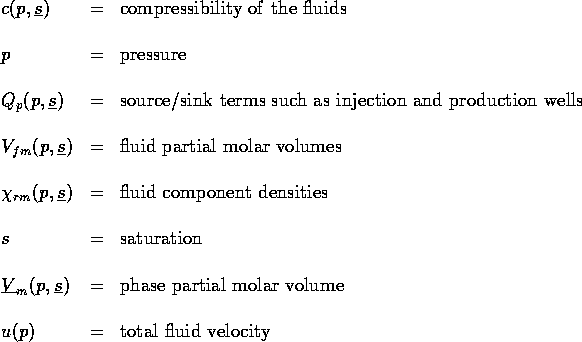
 That was 1989 and what you did was considered at that time to be one of the 20 national grand
challenges in science and engineering: petroleum reservoir simulation. What is the grand challenge
for you today?
That was 1989 and what you did was considered at that time to be one of the 20 national grand
challenges in science and engineering: petroleum reservoir simulation. What is the grand challenge
for you today?
 The
greatest grand challenge for any scientist is discovering
how to prevent the spread of HIV and finding
the cure or an effective vaccine for AIDS.
The
greatest grand challenge for any scientist is discovering
how to prevent the spread of HIV and finding
the cure or an effective vaccine for AIDS.
Eighty percent of Americans with HIV do not
know they are infected. One out of every 100 American men is
HIV positive. The rate of infection has reached epidemic proportions
in 40 developing nations. Worldwide, 23 million people are infected with the HIV virus.
Because I am not formally trained in the medical sciences, I can
bring in new ideas to AIDS research and the cross-fertilization of ideas
from different fields could be a valuable contribution to finding the
cure for AIDS.
It could be easier for me to develop an AIDS vaccine than to
solve the next grand challenge in
computer science.
 You have submitted 41 inventions to the U.S. Patent and Trademark Office concerning seven
technologies. Can you give us expanded details?
You have submitted 41 inventions to the U.S. Patent and Trademark Office concerning seven
technologies. Can you give us expanded details?
 Inventors are reluctant to
provided expanded details of their inventions until they receive full patent
protection. The reason is that the Patent and Trademark Office can deny patents to inventors that
publicly provided details of their invention.
Inventors are reluctant to
provided expanded details of their inventions until they receive full patent
protection. The reason is that the Patent and Trademark Office can deny patents to inventors that
publicly provided details of their invention.
Briefly, my inventions are on how to design powerful computers and
computations.
 You invented
the Hyperball
nature-inspired computer network, can you describe it for us?
You invented
the Hyperball
nature-inspired computer network, can you describe it for us?
 I observed that many problems that occur in nature possess
a spherical structure. For example, the Earth is spherical and, for this reason,
forecasting global warming is best done on a hyperball computer which
has numerous processing nodes interconnected in
a spherical-structure. This was
what motivated me to invent the hyperball computer.
I observed that many problems that occur in nature possess
a spherical structure. For example, the Earth is spherical and, for this reason,
forecasting global warming is best done on a hyperball computer which
has numerous processing nodes interconnected in
a spherical-structure. This was
what motivated me to invent the hyperball computer.
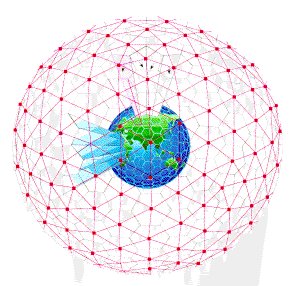
on photograph for full-scale Hyperball nature-inspired computer
network invented by Emeagwali. The red dots represents
the processing nodes while
the red lines shows which nodes are directly connected.
 You have
described your research approach as multi-disciplinary,
unorthodox, intuitive and
nature-inspired. Tell us more?
You have
described your research approach as multi-disciplinary,
unorthodox, intuitive and
nature-inspired. Tell us more?
 I am a mathematician who relies heavily on qualitative problem
solving techniques. I studied the
most influential scientists and inventors to learn what made them different
from ordinary people and
discovered that the most creative people in the world scored lower
than expected in SAT and IQ tests and most only earned high school diplomas.
I am a mathematician who relies heavily on qualitative problem
solving techniques. I studied the
most influential scientists and inventors to learn what made them different
from ordinary people and
discovered that the most creative people in the world scored lower
than expected in SAT and IQ tests and most only earned high school diplomas.
Henri Poincare, considered one of the world's greatest mathematicians,
had an extremely low IQ. Thomas Edison (electricity), Benjamin Banneker
(clock), Garret Morgan (traffic light), Henry Ford (automobile) and
Alexander Graham Bell (telephone) had 8th to 12th grade education. Bill Gates (microsoft),
Ted Turner (CNN), Bill Lear (Lear jet), Soichiro Honda (Honda cars), and Howard
Hughes (Hughes aircraft) never earned a college degree.
These geniuses had
average IQ but made the world a better place by using their intuition.
The lesson that I learned from the greatest inventors and scientists is that I will
invent and discover more things by deemphasizing quantitative methods and using
a multi-disciplinary, unorthodox, intuitive and nature-inspired
approach. I learned a lesson from Leonardo da Vinci (1452-1519) who
wrote:
"If you do not rest upon the good foundation of nature, you will labor with little
honor and less profit. [T]hose who take for their standard any one
but nature --- the mistress of all masters --- weary themselves in
vain."
 You have stated that
you have found algorithms, software and computers can be enantiomeric ---
that is, they have left-handed and right-handed versions like shoes.
How did you apply that
observation?
You have stated that
you have found algorithms, software and computers can be enantiomeric ---
that is, they have left-handed and right-handed versions like shoes.
How did you apply that
observation?
 Computers that are commercially available are
symmetric or non-handed but it is possible that some existing software and algorithms are left- or
right-handed. I have demonstrated that you can apply a righted-handed algorithm and software to a right-handed
computer. But I have not shown how to apply the right- and left-handed
algorithms and software to applications.
Computers that are commercially available are
symmetric or non-handed but it is possible that some existing software and algorithms are left- or
right-handed. I have demonstrated that you can apply a righted-handed algorithm and software to a right-handed
computer. But I have not shown how to apply the right- and left-handed
algorithms and software to applications.
How they can be applied may depend on the thought
processes that led to my discovering them. I discovered
enantiomeric computing by observing everyday things such as
fitting an ear muff over an ear, slipping our feet into shoes,
and putting our hands inside gloves.
Because I believe that humans are computers, I conjectured that
computers, like people, can have left- and right-handed
versions.
Since the left hand has a left glove that complements it,
I reasoned that a left-handed computer must have left-handed
software and algorithms that also complements it. Therefore,
efforts to implement a left-handed
software on a right-handed computer may be as
awkward as putting your left shoe on your right leg.
This discovery is weird and totally unexpected.
Because this discovery is
new, it will take a while to fully understand its
implications and applications. Our lives sometimes depends on computers
performing as predicted. When an algorithm or software is symmetric, that is, has no left-
and right-handed versions, it will not matter whether it is executed in a
right- or left-handed computer. For example, because a pen or fork or hammer is
symmetric, it does not matter whether we hold it in our right or left hand.
On the other hand, a glove is either right- or left-handed
and it matters whether we wear it in our right or left hands. It is possible
that a right-handed computer can perform in unpredictable manner
when a left-handed software is unintentionally executed in it.
On the optimistic side, it might be possible that a right-handed
computer may be more useful than a left-handed
computer. Remember the drug called thalidomide which is manufactured in both left- and right-handed
forms. One form of it causes
birth defects when taken by pregnant women and the other form is safely
prescribed by doctors as a sedative.
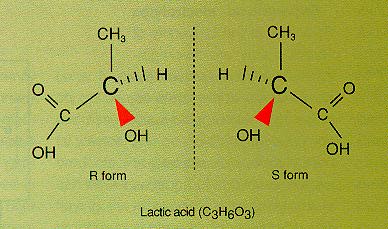
The right-
and left-hand versions of the lactic acid molecule.
(Scientific American, 1997)
 I am most intrigued by your statements in regards to nature and technology, and how your
computing networks have dealt with the awe inspiring powers of nature like the oil field flows, the
weather, the movement of the oceans. Are you on the brink of solving
any of nature's deeper
mysteries and what does a scientist owe mother nature?
I am most intrigued by your statements in regards to nature and technology, and how your
computing networks have dealt with the awe inspiring powers of nature like the oil field flows, the
weather, the movement of the oceans. Are you on the brink of solving
any of nature's deeper
mysteries and what does a scientist owe mother nature?
 Scientists try
to discover or unravel the mysteries of nature. Some of the problems we are
trying to solve has been solved in nature.
Scientists try
to discover or unravel the mysteries of nature. Some of the problems we are
trying to solve has been solved in nature.
My focus is not on solving nature's deeper mysteries. It is on
using nature's deeper mysteries to solve important societal problems.
Scientists and engineers draw their inspirations from nature. Physicists try to understand the
laws of nature. Mathematicians use symbols called partial differential equations
to describe natural phenomena such as weather forecasting and petroleum reservoir
simulation. Computer scientists try to design neural computers that emulate the human
brains. And so on.
 Why the choice of music for
your web site?
Why the choice of music for
your web site?

The music played
at my web site reflects my personal taste.
At home, I play soukous, highlife
and reggae. Highlife has a mesmerizing effect on me. Highlife dance band
music flourished in Nigeria and Ghana during the 1950s, 60s and 70s.
Soukous is an uptempo and infectious east African music that is a
current rage in Paris dance
halls. It has Congolese, Cuban and
Caribbean rhythms and elements of American country music of the 1930s and 40s. Soukous
live performances include energetic female show dancers and their fast shaking
of the pelvis. Sokous means "shake." I always feel delirious after a sokous concert.
Related articles/websites
 Emeagwali's Website
Emeagwali's Website
 Genius of our Age
Genius of our Age
 A Nigerian Hero
A Nigerian Hero
 Letters to Emeagwali
Letters to Emeagwali

Click on emeagwali.com for more information.


 Nigeria is a west African nation of over 100 million energetic
people. It is endowned with lots of natural resources but lacks human resources.
It was recently ranked by the World Bank
as the 13th poorest nation in the world. Due to financial reasons, I
dropped out of school after eight years of formal schooling. During
1967-70 period, my family was homeless. Sometimes, we slept in refugee
camps, abandoned school buildings and bombed houses.
Nigeria is a west African nation of over 100 million energetic
people. It is endowned with lots of natural resources but lacks human resources.
It was recently ranked by the World Bank
as the 13th poorest nation in the world. Due to financial reasons, I
dropped out of school after eight years of formal schooling. During
1967-70 period, my family was homeless. Sometimes, we slept in refugee
camps, abandoned school buildings and bombed houses.



 About Nigeria how do you envision your beginning affecting your end?
About Nigeria how do you envision your beginning affecting your end?







